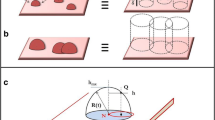Abstract
It is known that during electrodeposition or dissolution electrode shape change depends on the local current density (Faraday's law in differential form). Assuming that concentration gradients in the bulk of the solution may be neglected, the current distribution in an electrochemical system can be modelled by a Laplace equation (describing charge transport) with nonlinear boundary conditions caused by activation and concentration overpotentials on the electrodes. To solve this numerical problem, an Euler scheme is used for the integration of Faraday's law with respect to time and the field equation is discretized using the boundary element method (BEM). In this way, and by means of a specially developed electrode growth algorithm, it is possible to simulate electrodeposition or electrode dissolution. In particular, attention is paid to electrode variation in the vicinity of singularities. It is pointed out that the angle of incidence between an electrode and an adjacent insulator becomes right (π/2). This is confirmed by several experiments.
Similar content being viewed by others
Abbreviations
- x i :
-
coordinates of a point i belonging to a boundary (m)
- t :
-
time (s)
- h:
-
thickness variation at a point belonging to an electrode (m)
- M :
-
molecular weight (kgmol−1)
- ϱm:
-
specific weight (kgm−3)
- z :
-
charge of an ion (C)
- F :
-
Faraday's constant (C mol−1)
- R a2 :
-
impedance of the linearized activation overvoltage on cathode (S2 cm−2)
- θ:
-
efficiency of the reaction
- σ:
-
electric conductivity (Ω−1 m−1)
- U :
-
electric potential (V)
- \(\bar u\) :
-
rate of mechanical displacement of a point (m s−1)
- V :
-
applied potential on an electrode (V)
- W :
-
Wagner number defined as the ratio of the mean impedance of the reaction \(\left. {\frac{{\partial \eta }}{{\partial J}}} \right|_{Jav}\) and the mean ohmic resistance of the cell given by L/σ with L a characteristic length of the cell.
- η:
-
overvoltage (V)
- η1 :
-
overvoltage on anode (V)
- η2 :
-
overvoltage on cathode (V)
References
J. Newman, ‘Electrochemical Systems’, Prentice Hall, Englewood Cliffs, NJ (1973).
J. A. McGeough, ‘Principles of Electrochemical Machining’. Chapman & Hall, London (1974).
J. Deconinck, G. Maggetto, P. Versyck and J. Vereecken, ‘The Boundary Element Method (BEM) for Calculation of Current Distributions in Electrochemical Systems’. Extended abstracts of the 34th ISE Meeting, Erlangen, BRD (1983).
G. Finoly, A. Gernay and A. Giroud, ‘Application and Validation of the Boundary Element Method to Cathodic Protection Designs on Vessels’, XIVth International Conference on Boundary Element Methods, Vol. l, Sevilla, Nov. (1992) pp. 423–435.
F. Brichau and J. Deconinck, ‘A numerical model for cathodic protection of buried pipe lines’, accepted for publication in Corrosion (MACE).
J. Deconinck, ‘Current Distribution and Electrode Shape Changes in Electrochemical Systems — a Boundary Element Approach’, Lecture Notes in Engineering no. 75, Springer-Verlag (1992).
N. G. Zamani and J. M. Chuang, Electroplating, in ‘Topics in Boundary Element Research’, Vol. 7, Electrical Engineering Applications, Springer-Verlag (1990) Chapter 6.
G. A. Prentice, ‘Modeling of Changing Electrode Profiles’, Ph.D thesis, Lawrence Berkeley Laboratory, University of California (1980).
J. Ducovic and C. W. Tobias, J. Electrochem. Soc., 137 (1990) 3748–3755.
Author information
Authors and Affiliations
Rights and permissions
About this article
Cite this article
Deconinck, J. Mathematical modelling of electrode growth. J Appl Electrochem 24, 212–218 (1994). https://doi.org/10.1007/BF00242886
Received:
Revised:
Issue Date:
DOI: https://doi.org/10.1007/BF00242886




